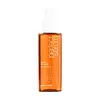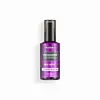What's inside
What's inside
 Key Ingredients
Key Ingredients

 Benefits
Benefits

 Concerns
Concerns

 Ingredients Side-by-side
Ingredients Side-by-side

Cyclopentasiloxane
EmollientDimethiconol
EmollientC12-15 Alkyl Benzoate
AntimicrobialParfum
MaskingArgania Spinosa Kernel Oil
EmollientSimmondsia Chinensis Seed Oil
EmollientCocos Nucifera Oil
MaskingLimonene
PerfumingPrunus Armeniaca Kernel Oil
MaskingOlea Europaea Fruit Oil
MaskingSclerocarya Birrea Seed Oil
HumectantCamellia Japonica Seed Oil
EmollientCoco-Caprylate/Caprate
EmollientLinalool
PerfumingCitronellol
PerfumingCaprylic/Capric Triglyceride
MaskingGeraniol
PerfumingCapsicum Annuum Extract
MaskingBeta-Carotene
Skin ConditioningTocopherol
AntioxidantGlycolipids
Skin ConditioningCyclopentasiloxane, Dimethiconol, C12-15 Alkyl Benzoate, Parfum, Argania Spinosa Kernel Oil, Simmondsia Chinensis Seed Oil, Cocos Nucifera Oil, Limonene, Prunus Armeniaca Kernel Oil, Olea Europaea Fruit Oil, Sclerocarya Birrea Seed Oil, Camellia Japonica Seed Oil, Coco-Caprylate/Caprate, Linalool, Citronellol, Caprylic/Capric Triglyceride, Geraniol, Capsicum Annuum Extract, Beta-Carotene, Tocopherol, Glycolipids
Cyclopentasiloxane
EmollientDimethicone
EmollientCyclohexasiloxane
EmollientIsododecane
EmollientIsopropyl Myristate
EmollientMacadamia Ternifolia Seed Oil
EmollientAmodimethicone
Squalane
EmollientVegetable Oil
Skin ConditioningIsopropyl Palmitate
EmollientTocopheryl Acetate
AntioxidantArgania Spinosa Kernel Oil
EmollientCarthamus Tinctorius Seed Oil
MaskingHelianthus Annuus Seed Oil
EmollientPersea Gratissima Oil
Skin ConditioningVitis Vinifera Seed Oil
EmollientCamellia Japonica Seed Oil
EmollientOryza Sativa Bran Oil
EmollientPrunus Amygdalus Dulcis Oil
Skin ConditioningPrunus Armeniaca Kernel Oil
MaskingSimmondsia Chinensis Seed Oil
EmollientRicinus Communis Seed Oil
MaskingLimnanthes Alba Seed Oil
Skin ConditioningSesamum Indicum Seed Oil
EmollientPlukenetia Volubilis Seed Oil
EmollientTocopherol
AntioxidantParfum
MaskingCyclopentasiloxane, Dimethicone, Cyclohexasiloxane, Isododecane, Isopropyl Myristate, Macadamia Ternifolia Seed Oil, Amodimethicone, Squalane, Vegetable Oil, Isopropyl Palmitate, Tocopheryl Acetate, Argania Spinosa Kernel Oil, Carthamus Tinctorius Seed Oil, Helianthus Annuus Seed Oil, Persea Gratissima Oil, Vitis Vinifera Seed Oil, Camellia Japonica Seed Oil, Oryza Sativa Bran Oil, Prunus Amygdalus Dulcis Oil, Prunus Armeniaca Kernel Oil, Simmondsia Chinensis Seed Oil, Ricinus Communis Seed Oil, Limnanthes Alba Seed Oil, Sesamum Indicum Seed Oil, Plukenetia Volubilis Seed Oil, Tocopherol, Parfum
 Reviews
Reviews

Ingredients Explained
These ingredients are found in both products.
Ingredients higher up in an ingredient list are typically present in a larger amount.
You may know this ingredient as argan oil. Argan Oil has antioxidant, hydrating, and soothing properties.
Studies have shown argan oil can help fight again radical damage from the sun. This makes it effective at preventing hyperpigmentation.
Large amounts of vitamin E found in argan oil helps the skin retain water. Argan oil also contains fatty acids such as linoleic acid, oleic acid, and palmitic acid. It is also a good source of lipids.
Another benefit of argan oil is skin-soothing. It can help reduce inflammation-related skin symptoms.
Argan Oil is effective at regulating sebum production in pores. This can make it effective at treating hormonal acne.
Traditionally, argan oil was used for its antibacterial and antifungal properties. However, argan oil contains fatty acids that may make it not fungal-acne safe.
Argan Trees are native to Morocco.
Learn more about Argania Spinosa Kernel OilCamellia Japonica Seed Oil comes from the Japanese Camellia plant. This plant is native to East Asia and known as "Tsubaki" in Japanese.
Camellia Japonica Seed Oil is rich in oleic acid. This makes it a great emollient. Emollients help soften and soothe the skin by forming a barrier. This barrier traps moisture within, keeping your skin hydated.
Cyclopentasiloxane, or D5, is a silicone used to improve texture of products and trap moisture.
D5 is considered lightweight and volatile. Volatile means it evaporates quickly after application. Once evaporated, D5 leaves a thin barrier that helps keep skin hydrated.
It is also an emollient. Emollients help soften the skin and prevent water loss. Silicones create a silky texture in products. D5 helps other ingredients become more spreadable.
Studies show D5 is safe to use in skincare products. We recommend speaking with a skincare professional if you have concerns.
Learn more about CyclopentasiloxaneParfum is a catch-all term for an ingredient or more that is used to give a scent to products.
Also called "fragrance", this ingredient can be a blend of hundreds of chemicals or plant oils. This means every product with "fragrance" or "parfum" in the ingredients list is a different mixture.
For instance, Habanolide is a proprietary trade name for a specific aroma chemical. When used as a fragrance ingredient in cosmetics, most aroma chemicals fall under the broad labeling category of “FRAGRANCE” or “PARFUM” according to EU and US regulations.
The term 'parfum' or 'fragrance' is not regulated in many countries. In many cases, it is up to the brand to define this term.
For instance, many brands choose to label themselves as "fragrance-free" because they are not using synthetic fragrances. However, their products may still contain ingredients such as essential oils that are considered a fragrance by INCI standards.
One example is Calendula flower extract. Calendula is an essential oil that still imparts a scent or 'fragrance'.
Depending on the blend, the ingredients in the mixture can cause allergies and sensitivities on the skin. Some ingredients that are known EU allergens include linalool and citronellol.
Parfum can also be used to mask or cover an unpleasant scent.
The bottom line is: not all fragrances/parfum/ingredients are created equally. If you are worried about fragrances, we recommend taking a closer look at an ingredient. And of course, we always recommend speaking with a professional.
Learn more about ParfumThis ingredient is the oil from the apricot.
Apricot Kernel Oil is an emollient and helps soften skin. This is due to its fatty acid components. Some of these fatty acids include linoleic and oleic acid.
This ingredient also has antioxidant properties from Vitamins A, C, and E. Antioxidants help fight free-radicals. Free-radicals are molecules that may damage your skin cells. Besides being antioxidants, these vitamins provide plenty of skin benefits as well.
Learn more about Prunus Armeniaca Kernel OilThis oil comes from the seeds of the desert shrub called Jojoba. It is more commonly known as jojoba oil, a non-comedogenic oil.
Jojoba oil does not contain fragrance and has many fatty-acids, making it a great soothing ingredient.
It also contains Vitamin E, a great moisturizing ingredient. Vitamin E is also an antioxidant and protects your skin against oxidative damage.
This ingredient humectant properties, meaning it helps draw moisture from the air. This helps keep your skin hydrated.
While jojoba has antibacterial properties, it is only able to kill some strains of bacteria.
Studies also show it helps in wound healing. In fact, Indigenous cultures have used jojoba as a moisturizer and to help treat burns for centuries.
Fun fact: Jojoba oil similar to natural human skin sebum, so it has a great effect on dry skin. It is also promising with helping to regulate sebum production.
Due to its fatty acid content, Jojoba oil may not be fungal acne safe. We recommend speaking with a professional if you have any concerns.
Learn more about Simmondsia Chinensis Seed OilTocopherol (also known as Vitamin E) is a common antioxidant used to help protect the skin from free-radicals and strengthen the skin barrier. It's also fat soluble - this means our skin is great at absorbing it.
Vitamin E also helps keep your natural skin lipids healthy. Your lipid skin barrier naturally consists of lipids, ceramides, and fatty acids. Vitamin E offers extra protection for your skin’s lipid barrier, keeping your skin healthy and nourished.
Another benefit is a bit of UV protection. Vitamin E helps reduce the damage caused by UVB rays. (It should not replace your sunscreen). Combining it with Vitamin C can decrease sunburned cells and hyperpigmentation after UV exposure.
You might have noticed Vitamin E + C often paired together. This is because it is great at stabilizing Vitamin C. Using the two together helps increase the effectiveness of both ingredients.
There are often claims that Vitamin E can reduce/prevent scarring, but these claims haven't been confirmed by scientific research.
Learn more about Tocopherol